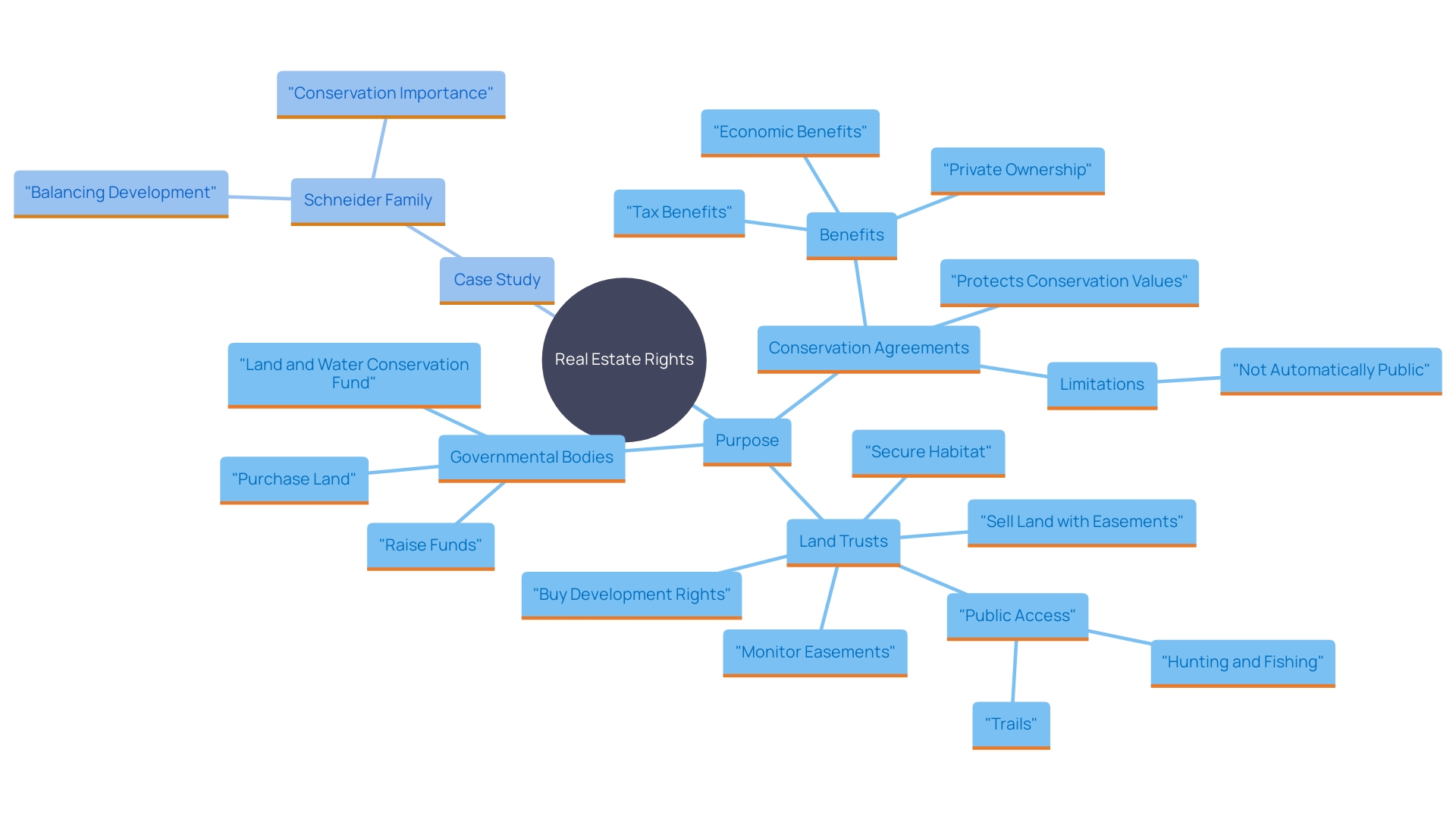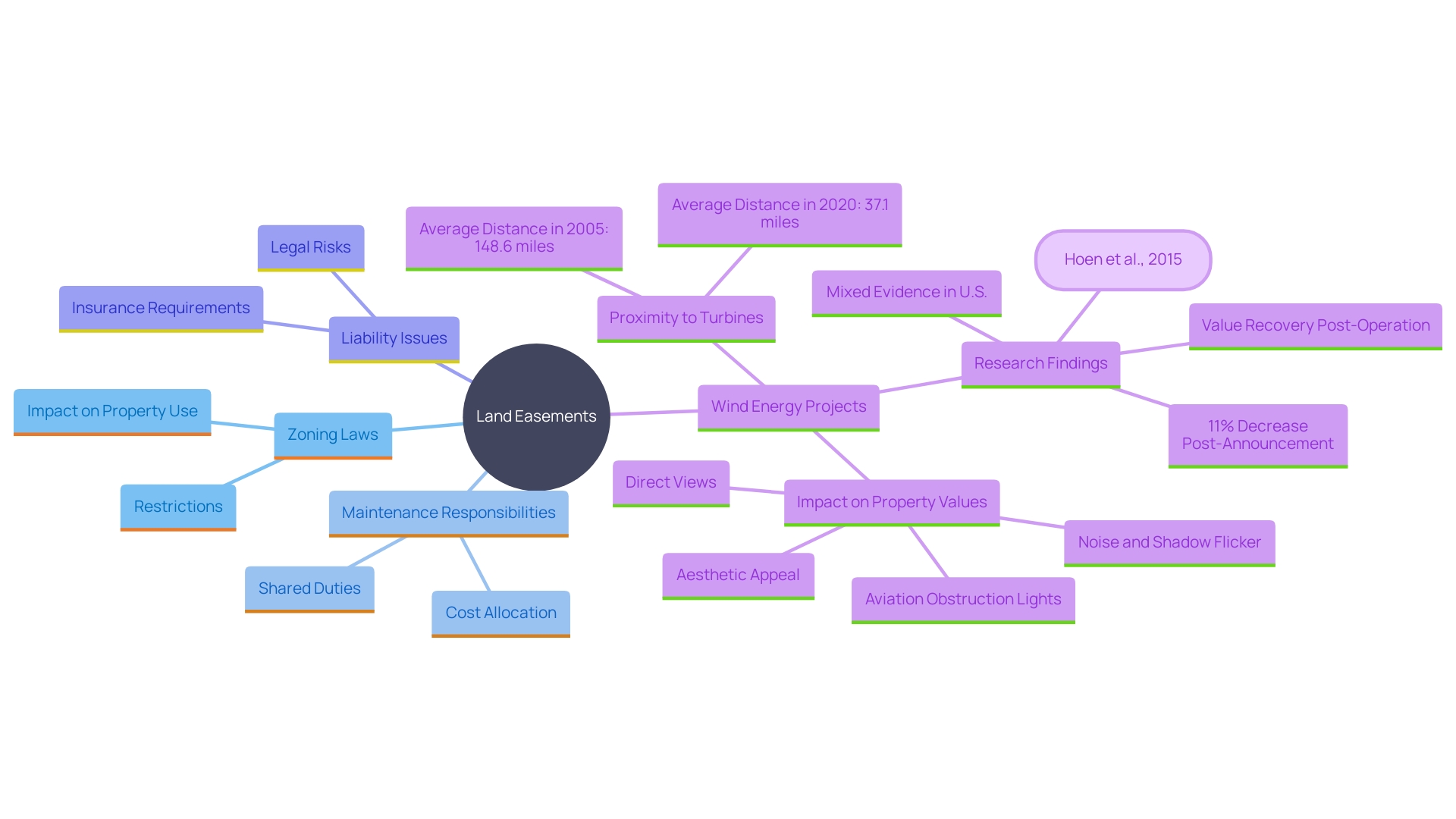Introduction
Land easements are a pivotal component in property law, allowing individuals or entities to utilize portions of another's property for designated purposes without transferring ownership. This article delves into the multifaceted nature of land easements, clarifying their definitions, types, and the key characteristics that differentiate them from other real property interests. It also explores the various methods through which easements can be created and terminated, emphasizing the legal implications and considerations crucial for property owners and easement holders alike.
Additionally, the article examines common examples and applications of easements, highlighting their significance in utility access, property development, and conservation efforts. Through detailed analysis and real-world case studies, the article provides a comprehensive understanding of how land easements function and their impact on land use and ownership.
Definition of Land Easements
A real estate right is a legal entitlement provided to a person or organization to utilize a section of someone else's estate for a particular aim without transferring ownership. Agreements permit the holder to enter or use the property in a specified way, providing advantages to both the holder and the owner. Common purposes for rights of way include utility access, transportation, and conservation.
A significant category of right of use is the conservation agreement, which is a voluntary, legally enforceable contract that permanently restricts uses of the property to safeguard its conservation values. Conservation agreements can be an effective method to safeguard property at a lower expense to land trusts and public organizations, as they maintain ownership in private hands while offering economic advantages to the region. If contributed, conservation agreements may also provide valuable tax advantages to landowners. Even though conservation agreements do not automatically allow access to the sites for the public, they guarantee the protection of the area for future generations.
Conservation agreements are employed by trust organizations and governmental bodies to protect different rights linked to an estate. For instance, the Water Conservation Fund, entirely financed by the Great American Outdoors Act, aids in the acquisition of new public areas. Land trusts often retain a conservation easement on properties sold to private buyers, ensuring ongoing protection. This approach distinguishes various rights, such as development and grazing rights, thereby preserving the ecological and economic value of the area.
The Schneider family case emphasizes the complexities involved in property use planning. 'Despite their willingness to donate conservation areas, the township's demand for additional infrastructure, such as a parking lot, poses challenges due to the ecologically sensitive nature of the region.'. This situation underscores the importance of balancing development needs with conservation efforts.

Types of Easements
Land rights come in various forms, each tailored to address specific needs and circumstances. The primary types include:
-
Appurtenant Easements: These benefit a particular parcel of property, known as the dominant estate. Associated rights are connected to the property and pass automatically with the estate when it is sold. This type ensures that the dominant estate can continue to benefit from the right of way regardless of ownership changes.
-
Rights of Way in Gross: Unlike appurtenant rights, these are granted to individuals or entities rather than being linked to a specific parcel of land. Rights in gross do not convey with the real estate; rather, they stay with the person or organization that initially obtained the right. This type is prevalent for utility companies that need access across various locations.
-
Prescriptive Rights: These are obtained through continuous, open, and notorious use of the property without the permission of the owner over a statutory period. Once created, a prescriptive right becomes legally enforceable, granting the user certain privileges to the land as if they had been formally granted such a right.
-
Easements by Necessity: These arise when a parcel of property is landlocked, meaning it has no legal access to a public road or utility. A right of way by necessity guarantees that the landlocked area can reach essential services, which could otherwise be unfeasible. This type is often granted by courts to ensure fairness and practicality in land use.
Grasping these various kinds of rights of way is essential for landowners, developers, and stakeholders engaged in real estate transactions and development initiatives. Each category serves unique functions and has particular legal consequences that must be thoroughly evaluated to prevent possible disputes and ensure adherence to real estate regulations.
Key Characteristics of Easements
Easements have several notable characteristics that set them apart from other interests in real property:
- Non-Possessory Interest: The easement holder does not own the land but has the right to use it. For example, conservation agreements enable property owners to maintain ownership while restricting usage to safeguard conservation principles, thereby ensuring the property stays private.
- Specific Purpose: Rights of way are granted for a particular use, which must be adhered to by the holder. This is clear in conservation agreements, which are contracts to protect areas for preservation objectives, preventing certain types of development.
- Duration: Easements can be temporary or permanent, depending on the agreement between parties. Conservation agreements, for instance, are frequently permanent to guarantee long-term safeguarding of the land.
- Transferability: Appurtenant rights usually convey with the asset, whereas in gross rights might not. Conservation agreements generally stay with the land and keep delivering economic advantages to the region, frequently providing tax incentives to landholders.
Easement Creation Methods
Easements can be established through several methods, each with distinct implications for land development and access. The most common method is through a Written Agreement, where the terms and conditions are explicitly stated and mutually agreed upon by the involved parties. This approach provides clarity and legal certainty, ensuring both parties understand their rights and obligations.
Another method is through Implication, which arises from the actions and circumstances of the parties involved, even if not formally documented. This kind of right of way often arises from long-standing practices that suggest an implied agreement.
Essential rights are established when a landowner needs access to an enclosed lot, allowing them the privilege to traverse someone else's terrain to arrive at their estate. This is essential for ensuring landowners can fully utilize their property, especially in cases where no other access is available.
Termination of Easements
Easements can be terminated under several specific circumstances:
- Expiration: When an easement is created for a specified duration, it automatically ends once that period expires.
- Abandonment: If the right of way holder stops using the right of way for an extended period, it may be considered abandoned. In the case of the Texas Parks and Wildlife Department, their prolonged non-use and subsequent purchase offer refusal led to the termination of their rights over the Fairfield Lake State Park.
- Merger: If the dominant and servient estates come under common ownership, the right of way is extinguished. For instance, the merger of land ownership by Todd Interests in Freestone County concluded prior access agreements.
- Legal Action: Courts can terminate rights of way if they are deemed no longer necessary or if they violate legal statutes. For example, the dismantling of a wind project in southern France due to noise pollution and bird deaths highlighted how legal actions can lead to the termination of land agreements when public interest or environmental concerns are at stake. Likewise, the Osage Minerals Council has effectively utilized legal measures to safeguard their mineral estate rights from illegal access related to wind turbine construction.
These termination conditions ensure that rights of way remain pertinent and legally compliant, reflecting changing usage and ownership requirements.
Legal Implications and Considerations
Grasping the legal consequences of land easements is essential for both landowners and easement holders. Key considerations include:
-
Zoning Laws: Easements must comply with local zoning regulations, which can significantly impact their use. For example, recent legislation in Georgia concerning the Sandersville Railroad emphasizes the complexities of zoning laws in deciding whether a railroad can legally condemn land to construct a rail line. The outcome could set significant precedents for property law.
-
Maintenance Responsibilities: Typically, the holder of the right of way is responsible for maintaining the designated area. However, this can vary based on the specific terms of the agreement. For instance, conservation agreements, like those overseen by the Summit Land Conservancy and Utah Open Lands, frequently contain specific clauses regarding maintenance duties to guarantee the land's preservation.
-
Liability: The holder of the right of way may face certain liabilities associated with the use of this right, especially if it involves public access. Legal instruments such as mandatory unitization or pooling, as highlighted by researchers, are intended to guarantee equitable distribution of revenues or resources but can also create substantial obligations for rights holders.
Additionally, the rapid expansion of wind energy projects, as evidenced by a study of 428 unique projects and nearly 500,000 housing sale transactions, shows that proximity to infrastructure developments can impact property values. This highlights the significance of comprehending all legal consequences when handling property rights.

Common Examples and Applications
Land rights play a crucial role in various applications, each serving unique purposes and addressing different needs.
-
Utility Rights of Way: These allow utility companies to install and maintain essential infrastructure such as power lines, water pipes, and communication cables. They ensure that utilities can deliver services efficiently and maintain access for repairs and upgrades.
-
Access Rights: Often important in real estate transactions, access rights grant necessary entry to sites that would otherwise be landlocked and unreachable. This facilitates the use of plots that do not have direct road access and can significantly enhance property value and usability.
-
Conservation Easements: These are legally binding agreements between property owners and trusts or government agencies aimed at protecting environmentally sensitive areas. Conservation agreements limit development to protect natural environments while maintaining private ownership of the property. They provide economic benefits to local areas and often come with valuable tax incentives for landowners. These easements are a cost-effective tool for conservation trusts and public agencies to maintain ecological balance without public ownership. Notably, they do not automatically open the land to public access but ensure its conservation for future generations.
Conclusion
Land easements serve as a vital mechanism in property law, enabling individuals and entities to utilize portions of another's property for specific purposes while maintaining ownership rights. The article outlined the various types of easements, including appurtenant, easements in gross, prescriptive easements, and easements by necessity, each designed to cater to distinct needs and circumstances. Understanding these classifications is essential for property owners and stakeholders to navigate the complexities associated with land use and ownership.
Key characteristics of easements, such as their non-possessory nature, specific purpose, and potential for transferability, underscore their unique role in real property interests. The methods through which easements can be created—whether through written agreements, implication, or necessity—further illustrate the legal frameworks that govern these rights. Additionally, the conditions under which easements may be terminated, including expiration, abandonment, and legal action, highlight the importance of maintaining relevance in evolving land use contexts.
The legal implications surrounding easements, particularly regarding zoning laws, maintenance responsibilities, and liability, are crucial considerations for both property owners and easement holders. The examples of utility, access, and conservation easements demonstrate the diverse applications these rights can have, from facilitating essential services to preserving ecological values. Overall, a comprehensive understanding of land easements is imperative for effective property management and development, ensuring that all parties involved can navigate the legal landscape with clarity and foresight.




